| Article ID | Journal | Published Year | Pages | File Type |
|---|---|---|---|---|
| 5113428 | Quaternary International | 2017 | 9 Pages |
Abstract
Shell middens, large heaps of refuse materials that are often interspersed with burials, hearths and other cultural features, provide important data regarding the lifestyles of past coastal and maritime dwellers. Despite the abundance of organic materials, radiocarbon ages from shell middens can be a challenge to interpret because marine shells are depleted in radiocarbon with respect to their contemporaneous atmosphere, known as the “reservoir effect” (R). This issue is particularly problematic in regions like the coastal Atacama Desert where the upwelling of subsurface radiocarbon-depleted waters creates a shell “local” reservoir effect (ÎR) with a time-variable intrinsic uncertainty. Here we review and discuss how the dating of diverse materials from these deposits, including the shells themselves, can reveal large shifts between the terrestrial (atmospheric) and marine carbon cycles. Furthermore, a chronology of such shifts can be used as a proxy of upwelling intensity and to help establish the duration of strong versus weak local upwelling episodes. To test and evaluate these ideas, we present a chronology of R and ÎR variations from a 2-m shell midden sequence from Caleta Vitor in northern Chile that spans the middle Holocene, which remains underrepresented by regional ÎR values. The â¼2000Â y sequence of Caleta Vitor, located onshore from a major upwelling center, displays dramatic shifts in radiocarbon reservoir effects which we hypothesize are linked to strong changes in the intensity of local upwelling. Further replication of such archaeomalacological records will be key for not only solving methodological problems regarding the dating of coastal sites but can provide further insights into the evolving terrestrial and marine carbon cycles and how these relate to past climate change.
Related Topics
Physical Sciences and Engineering
Earth and Planetary Sciences
Geology
Authors
Claudio Latorre, Ricardo De Pol-Holz, Chris Carter, Calogero M. Santoro,
